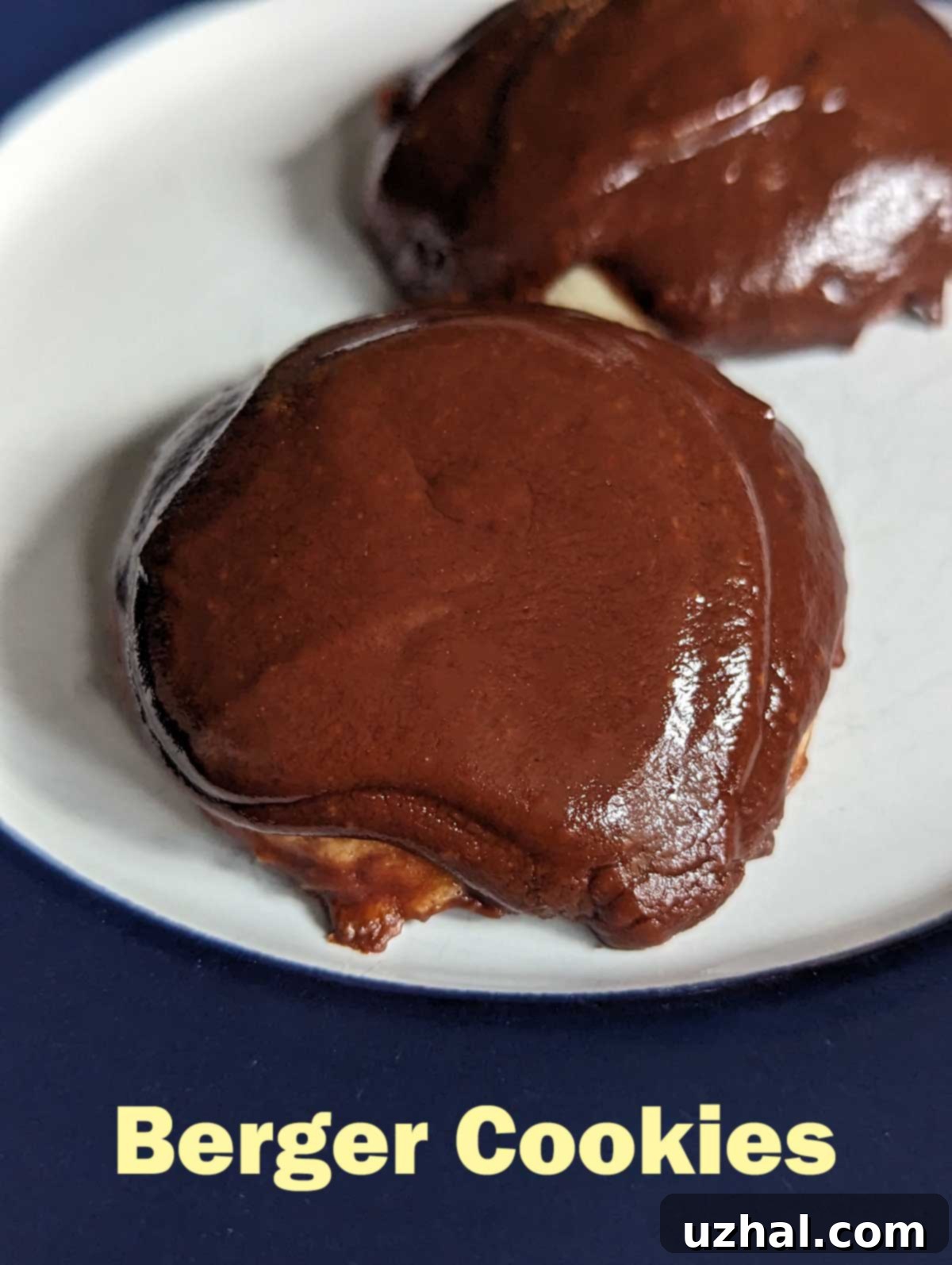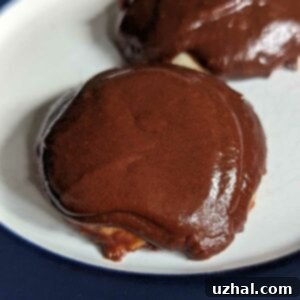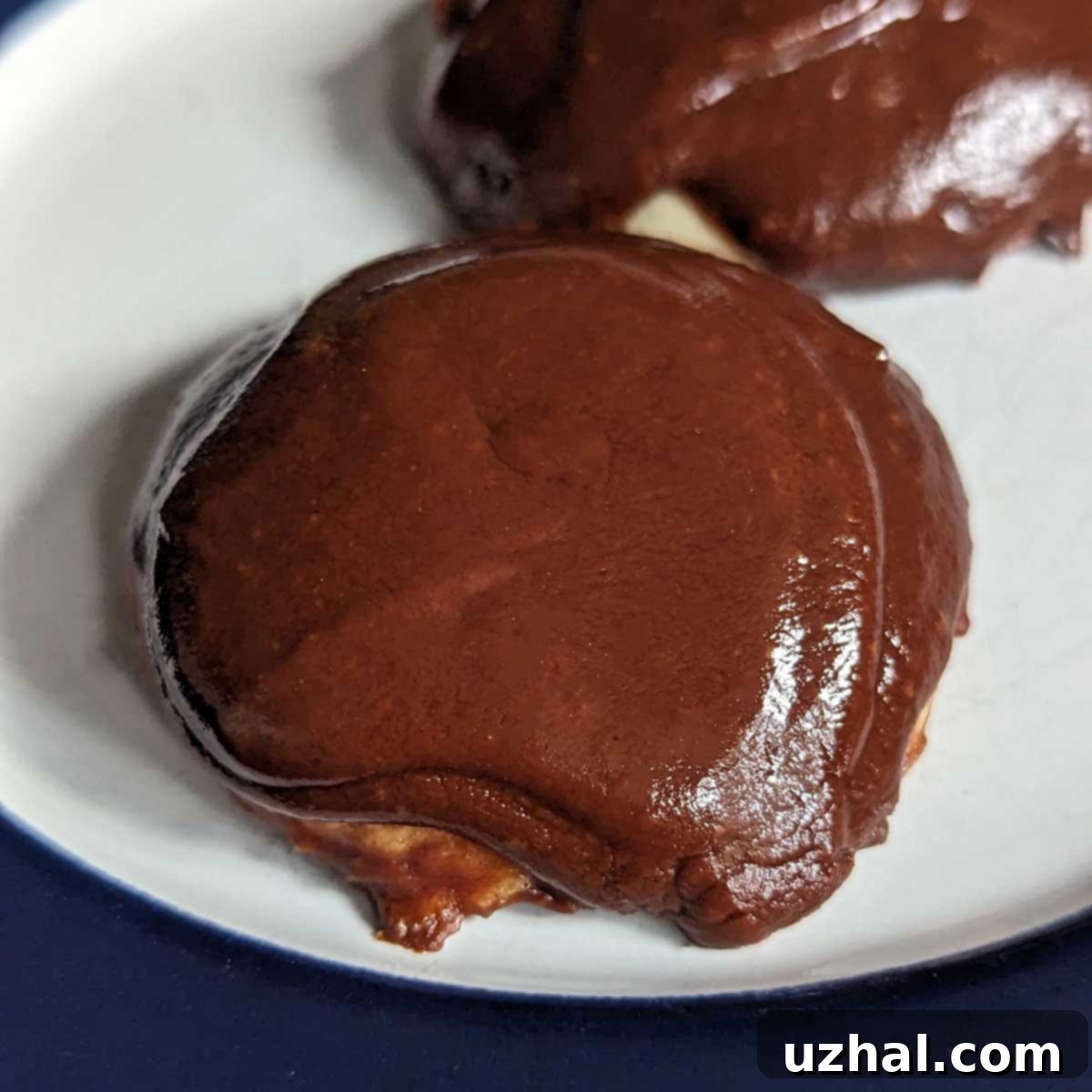The Ultimate Homemade Berger Cookies Recipe: Maryland’s Iconic Chocolate Fudge Delight
Maryland is a state steeped in culinary traditions, and among its most cherished delights are the famous Berger Cookies. Years ago, I curiously asked a friend from Maryland if she had ever heard of these iconic treats, only to my surprise, she hadn’t! This sparked my intrigue. I had hoped she could share the rich history and cultural significance behind these renowned Baltimore cookies. Alas, the journey to uncover their story and master their creation became my own delicious quest, leading me down a delightful path of research and baking experiments. What I discovered was a cookie truly unlike any other, a testament to enduring flavor and local heritage.

For years, Berger Cookies have been celebrated for their distinctive profile: a thick, soft, cakey vanilla sugar cookie base generously topped with an opulent layer of rich chocolate fudge icing. While their fame extends throughout Maryland, they are particularly revered in Baltimore, their birthplace. The original Berger Cookies were conceived in 1835 by German immigrant brothers George and Henry Berger. Their timeless recipe has cemented these cookies as a true Baltimore staple, a local legend passed down through generations. Today, you can easily purchase authentic Berger Cookies online or from various retailers across the state. However, given their delicate nature, especially the thick chocolate fudge that doesn’t fare well in hot weather, I decided to embark on a culinary adventure to create a homemade “clone” version before placing an order. My goal was to capture that unique taste and texture right in my own kitchen.
The Quest for the Perfect Recipe: King Arthur’s Berger Cookie Recipe
My search for an authentic Berger Cookie recipe clone quickly led me to the highly regarded King Arthur Baking Company’s version. This recipe seemed to be the benchmark for home bakers attempting to replicate the Maryland classic, a testament to King Arthur’s reputation for reliable and delicious baking formulations. They originally offered two versions of the famous Maryland cookies, and I initially chose to work with version 2. However, it’s worth noting an update: King Arthur has since combined their two versions into a single, comprehensive recipe, streamlining the process for bakers. The picture below shows the older version I initially tried, while the first picture in this post reflects the results from the updated, consolidated recipe that I now use as my base. It’s a wonderful starting point for anyone looking to make these delightful cookies at home.
First Bake: Initial Impressions and Refinements
My initial baking round with the King Arthur recipe yielded genuinely good cookies. The base, as expected, was a delightful cakey vanilla cookie, remarkably similar in texture and lightness to the base of a classic Black & White cookie. This soft, slightly domed foundation provides the perfect counterpoint to the rich topping. Speaking of the topping, the fudge icing was wonderfully soft, deeply rich, and sweet – everything you’d expect from a Berger Cookie. To subtly temper the inherent sweetness of the fudge and enhance the chocolate flavor, I opted for extra dark chocolate chips instead of semisweet. This small change added a layer of sophistication to the overall taste profile. Furthermore, I was meticulous in weighing and sifting the confectioners’ sugar for the icing. This step is crucial; too much or too little can drastically alter the fudge’s consistency and final sweetness, proving that precision is key in achieving that perfect, pourable yet thick fudge layer.
While I thoroughly enjoyed the cookies from this first attempt, I felt there was still room to refine the fudge topping to truly match my ideal vision of a Berger Cookie. For now, however, I wholeheartedly recommend King Arthur’s version as an excellent starting point. The cookies were undeniably beautiful to look at and absolutely delicious to eat, making them a fantastic introduction to the world of homemade Berger Cookies. My journey to perfect them was off to a truly promising start.
Adapting the Recipe: My Maple Syrup Modification
As of 2023, the King Arthur recipe has been thoughtfully updated, consolidating its previous iterations into an even more robust and reliable guide. It’s an undeniably strong recipe, one that I found incredibly dependable. I’ve included an adapted version below, incorporating a minor but impactful change to the icing recipe. In a moment of improvisation, I found myself out of corn syrup, a common ingredient in fudge for its texture-enhancing properties. Instead, I decided to experiment with maple syrup, and to my pleasant surprise, it worked beautifully! The maple syrup not only contributed to a lovely smooth texture in the fudge but also lent a subtle, earthy sweetness that complemented the dark chocolate wonderfully, creating an even more complex flavor profile. This adaptation proves that sometimes, necessity truly is the mother of invention in the kitchen, and delightful discoveries can be made when straying slightly from the original path.
- Jacques Pépin Chocolate Chunk Cookies — Scharffen Berger
- King Arthur’s Cinnamon Rolls
- King Arthur Chocolate Muffins
- Soft & Chewy Whole Wheat Chocolate Chip Cookies
- Easy Cocoa Powder Fudge Brownies
Recipe

Homemade “Clone” of Berger Cookies
Anna
Pin Recipe
Ingredients
- 5 ⅓ tablespoons unsalted butter, softened (74 grams) – Ensuring your butter is properly softened is key for a smooth dough texture.
- ½ teaspoon salt
- 1 teaspoon pure vanilla extract, King Arthur’s is recommended – High-quality vanilla makes a big difference in the cookie’s flavor.
- 1 teaspoon baking powder
- ½ cup granulated sugar (99 grams)
- 1 large egg, bring to room temperature – Room temperature eggs emulsify better, leading to a smoother batter.
- 1 ½ cups all-purpose flour (KA says unbleached) (180 grams) — Go by weight for accuracy in baking.
- ⅓ cup whole milk (74 grams) – Use whole milk for richness in the cookie base.
Chocolate Fudge Icing
- 2 cups dark or semisweet chocolate chips – I prefer dark chocolate for a less sweet, richer fudge.
- 1 ½ cups confectioners’ sugar, sifted as per the directions (170 grams) – Sifting is vital for a smooth, lump-free icing.
- 1 ½ tablespoons maple syrup (30 grams) – My preferred alternative to corn syrup, it adds a lovely flavor and sheen.
- ¾ cup heavy cream, best quality – A higher fat content cream will result in a creamier, more stable fudge.
- 1 teaspoon vanilla extract
Instructions
-
Preheat oven to 350°F (175°C). This initial temperature is for starting the cookie base, ensuring even baking before a final slight increase. Prepare your baking sheets by lining them with parchment paper.
-
In a large mixing bowl, beat the softened butter until creamy. Then, add the salt, vanilla, and baking powder, beating just until combined. Next, gradually beat in the granulated sugar and the room temperature egg. The way I’ve found best for these cookies is to beat only until fully blended, rather than incorporating a lot of air. This technique helps achieve a denser, more cakey cookie base, which is characteristic of Berger Cookies, preventing them from becoming too light and airy.
-
With your mixer on low speed or using a sturdy silicone scraper or wooden spoon, alternately add the flour and the whole milk to the butter mixture, starting and ending with flour. Mix until you have a thick but scoopable batter. Be careful not to overmix, as this can develop the gluten too much, leading to a tough cookie. The batter should be notably sticky, which is perfectly normal for this type of cookie.
-
Now, increase your oven temperature to 400 degrees F (200°C). This higher temperature helps the cookies set quickly and develop a slightly crisp edge while keeping the inside tender.
-
Using a tablespoon or a small cookie scoop (approximately 1.5 tablespoons in size), scoop out 20 rounds of dough. Try to make them as uniform in size as possible for even baking.
-
Transfer 10 of the dough balls to a parchment-lined baking sheet, ensuring they are spaced about 2 ½ inches apart to allow for spreading. Lightly dampen your fingers or the back of a small spoon with water and gently press the tops of each dough round down slightly. This helps them flatten out just enough to create the signature Berger Cookie shape. Aim for neat, slightly flattened discs of dough before baking.
-
Bake at 400°F (200°C) for 10 to 11 minutes, or until the edges are lightly golden brown and the centers are set. The cookies should be soft to the touch. Once baked, remove them from the oven and transfer them to a wire rack to cool completely. While the cookies are cooling, you can begin preparing the rich chocolate fudge icing. You can ice them while they are slightly warm for a softer fudge, or wait until they are completely cool for a firmer, more set topping.
-
For the icing, it’s essential to prepare your dry ingredients first. Sift about 1 ½ cups of confectioners’ sugar (weighing out 170 grams for ultimate accuracy). Mix this sifted sugar with the salt in a small bowl. This ensures there are no lumps in your final fudge.
-
In a microwave-safe mixing bowl, combine the chocolate chips, heavy cream, and maple syrup. Heat on high for 30 seconds. If you have a very high-powered microwave, you might opt for 50% power to prevent scorching the chocolate. Stir the mixture, then repeat heating in 15-second intervals, stirring after each, until the mixture is very hot and the chocolate is mostly melted. Continue to stir vigorously until the chocolate is fully melted and the fudge is completely smooth and glossy. Add the vanilla extract, then gradually incorporate the sifted confectioners’ sugar and salt mixture, beating until the icing is smooth and free of lumps. At this stage, it will be a fairly loose consistency, but it will thicken beautifully as it cools.
-
Once the cookies are cool enough to handle, dip the flat bottom of each cookie generously into the chocolate fudge icing. Then, carefully flip them over and set them icing side up on parchment paper to allow the fudge to set. I often like to hold back a portion of the icing and let it cool slightly, then spoon more onto the top of the already dipped cookies as it thickens. This technique allows the fudge to pile up higher and create that iconic, thick, domed appearance of a true Berger Cookie.
-
While you can certainly enjoy these delectable cookies right away, they truly reach their peak deliciousness once the rich fudge topping has fully set. This can take anywhere from an hour to a few hours at room temperature, or you can expedite the process by placing them in the refrigerator for about 30 minutes. The waiting is the hardest part, but entirely worth it!
Tips for Crafting Flawless Homemade Berger Cookies
Achieving the perfect Berger Cookie at home is a rewarding experience, and a few key tips can elevate your baking from good to extraordinary:
- Quality Ingredients Matter: Since these cookies have relatively few components, the quality of each ingredient shines through. Use good unsalted butter, high-quality vanilla extract, and the best heavy cream you can find. For the chocolate, choose a brand you genuinely enjoy eating, as its flavor will dominate the fudge.
- Accuracy in Measurement: Baking is a science, and nowhere is this more true than with cookies and icing. Using a kitchen scale to measure flour, sugar, and chocolate chips (as specified in grams in the recipe) will yield the most consistent and professional results. Eyeballing measurements, especially for confectioners’ sugar in the fudge, can lead to a runny or overly stiff icing.
- Don’t Overmix the Dough: The hallmark of a Berger Cookie base is its cakey, tender texture. Overmixing the flour once it’s added will develop the gluten, resulting in a tougher, chewier cookie rather than the desired soft, almost biscuit-like crumb. Mix only until the ingredients are just combined.
- Perfecting the Fudge Consistency: The fudge icing should be thick enough to hold its shape but still pourable for dipping. If your fudge seems too thin, you can add a little more sifted confectioners’ sugar, a tablespoon at a time, until it reaches the desired consistency. If it’s too thick, a tiny splash of warm heavy cream can thin it out. Remember, it will thicken significantly as it cools.
- Patience with Setting: The fudge topping needs time to set properly. While they are delicious warm, allowing the cookies to sit for an hour or two (or chilling them briefly) will give the fudge that characteristic firm yet yielding texture that makes Berger Cookies so unique.
- Storage: Store Berger Cookies in an airtight container at room temperature for up to 3-4 days. For longer storage, they can be frozen for up to 2 months. Thaw at room temperature before serving.
Why Berger Cookies Capture Hearts: More Than Just a Treat
Berger Cookies are more than just a dessert; they are a culinary institution in Maryland, embodying a unique blend of simplicity and indulgence. Their enduring popularity stems from the delightful contrast between the soft, vanilla-infused cake base and the thick, intensely chocolatey fudge layer. Each bite offers a satisfying duality of textures and flavors that is truly addictive. They evoke a sense of nostalgia for many Marylanders, a taste of home and tradition. Making them from scratch not only allows for customization, like my maple syrup fudge adaptation, but also connects you to a rich history of German immigrant baking that has shaped Baltimore’s sweet landscape. Whether you’re a long-time fan or a curious newcomer, baking these homemade Berger Cookies is a delightful journey that culminates in a truly special treat, perfect for sharing, celebrating, or simply savoring a piece of Maryland’s delicious heritage.
